
The best plants for Arizona heat in the summer are succulents – such as cacti, agaves, aloes, and yuccas – and lovely desert trees, shrubs, ground covers, and flowering plants. Local nurseries have beautiful varieties with unique colors and textures.
When choosing outdoor plants in Arizona, remember that besides complementing the landscape design, they must also fit your yard’s sun exposure. Aloe’s tender leaves can get sunburns in the direct afternoon light, while lantana and yellow bells need full sun exposure to thrive and bloom.
Local winter temperatures are also important. Arizona, the sixth largest state by area, covers USDA hardiness zones from 4b ( -20 to -25°F in the winter) to 10b (minimums of 30 to 40°F). If you live in Kingman, Nogales, Prescott, or Flagstaff, look for perennials that can survive the cold in your area.
Since some yuccas can grow up to 20 feet wide, also factor in the plant’s size at maturity versus the space in your garden.
This being said, let’s take a look at the top plants to grow in Arizona’s heat. We’ve grouped them by type, so you can skip directly to your desired plant category.
Top Flowering Plants for Arizona’s Hot Climate
Flowering plants add depth, colors, and energy to arid gardens, and some also look excellent in vases and dry arrangements. Here are a few heat-resistant options that can handle the desert summer with grace and joy.
Marigolds (Tagetes spp.)
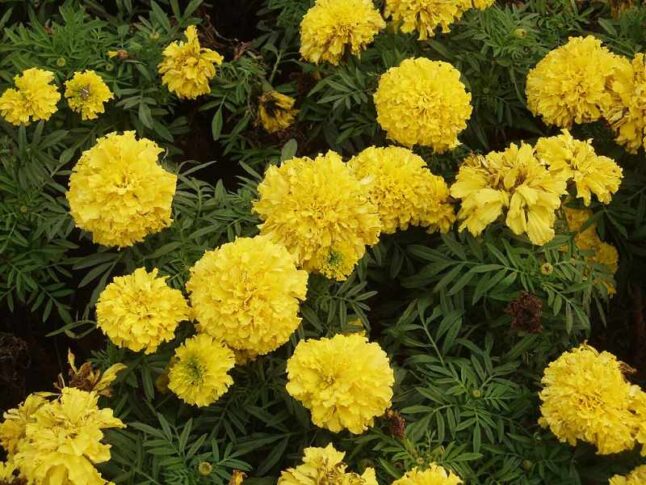
From midsummer until late fall, marigolds add festive colors and textures to your garden. They have dense, rounded flowers with many layers of bright-colored petals. They also contain phytochemicals that protect flower beds and vegetable plots from pests. The most common marigolds planted in Arizona are:
- African marigolds
- French marigolds
- Dwarf marigolds
Type: Annuals, perennials.
USDA hardiness zones: 2 to 11.
Sun exposure: Full sun.
Drought tolerance: Very good.
Size: 6 to 36 inches tall.
Color: Yellow, gold, and orange to ivory and mahogany.
Maintenance:
- Mulch the soil around the marigolds.
- Water regularly during drought, but let the soil dry between two waterings.
Marigold companions: Salvia, coreopsis, lavender, geranium.
Zinnia (Zinnia elegans)
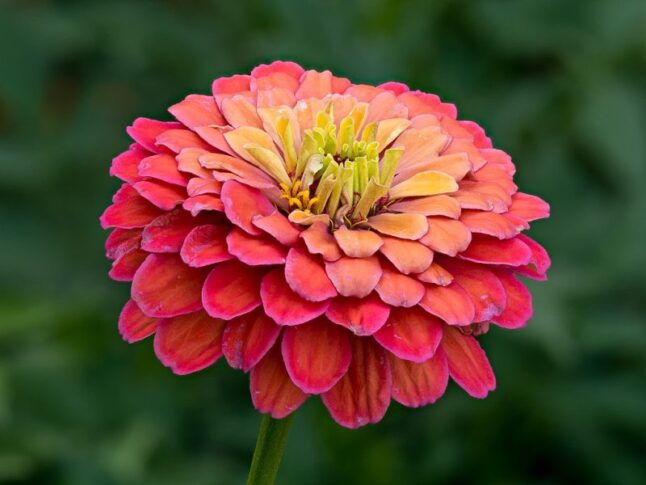
Plant colorful zinnias along garden beds and borders. Grown in groups, these annual plants with bright, daisy-like flowers add vibrant hues to landscapes and attract useful pollinators. Besides enhancing your lawn’s looks, zinnias also make for excellent cut flowers lasting up to 10 days in a vase.
Type: Annuals.
USDA hardiness zones: 2 to 11.
Sun exposure: Full to part shade.
Drought tolerance: Good.
Size: Six to thirty inches tall.
Color: Blooms from April to November with white, yellow, orange, and dark red flowers.
Maintenance:
- Remove spent flowers to encourage further blooming.
- Water once a week in the dry and hot summers of Tucson, Phoenix, and Yuma areas.
Zinnia companions: marigolds, black-eyed Susan, sunflowers
Bougainvillea (Bougainvillea spectabilis)
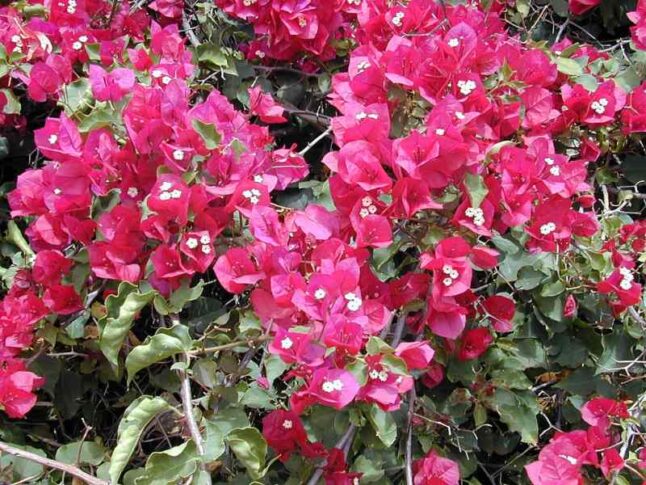
Plant this fast-growing, easy-to-care-for vine with stunning flowers to create natural, colorful privacy screens. It fills with vibrant hues each summer, provides lovely shade, and is a perennial that returns every year once established. Install near walls and patios and climb it on a trellis or pergola for shade.
Type: Perennial.
USDA hardiness zone: 9 to 11.
Sun exposure: Full sun and light shade.
Drought tolerance: Very good.
Size: This vine can climb up to 20 – 30 feet with proper support.
Color: From golden yellow, pink, and red to magenta and purple.
Maintenance:
- It needs regular watering during the first growing season.
- After that, water deeply once every 3 to 4 weeks.
Bougainvillea companions: carissa, Texas sage, muhly grass, dwarf oleander.
Beardtongues (Penstemon spp.)
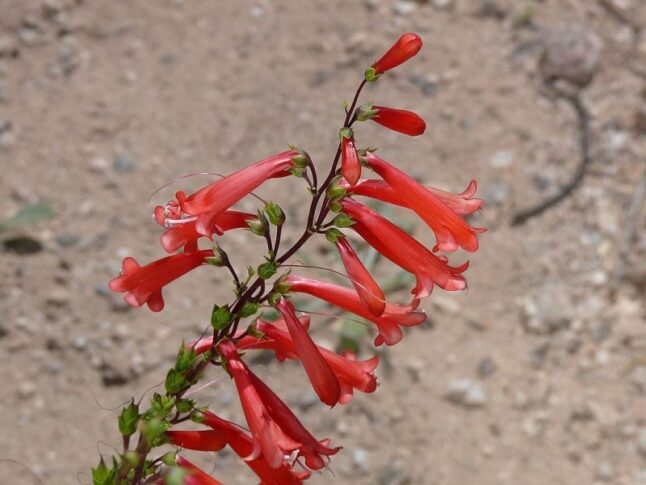
Less lush and rich in foliage than the bougainvillea, penstemons conquer your soul with their lovely, colorful flowers. They bloom in early spring, need little watering, and are suitable for xeriscape designs. The most common varieties to grow in the Phoenix area are:
- Parry’s penstemon
- Scented beardtongue
- Arizona penstemon
- Red penstemon
- Firecracker penstemon
Type: short-lived perennials, living 2 to 5 years.
USDA hardiness zone: 3 to 9.
Sun exposure: Full sun to light shade.
Drought tolerance: Very good.
Size: Pestemons range from low-growing ground covers to flower stems reaching 5-6 feet.
Color: Penstemons bloom in late spring and early summer with white, yellow, orange, pink, and red flowers.
Maintenance:
- Water occasionally during summer.
- Don’t fertilize.
Penstemon companions: agave, brittlebush, angelita daisy, marigold, prickly pear cactus.
Amaranth (Amaranthus spp.)
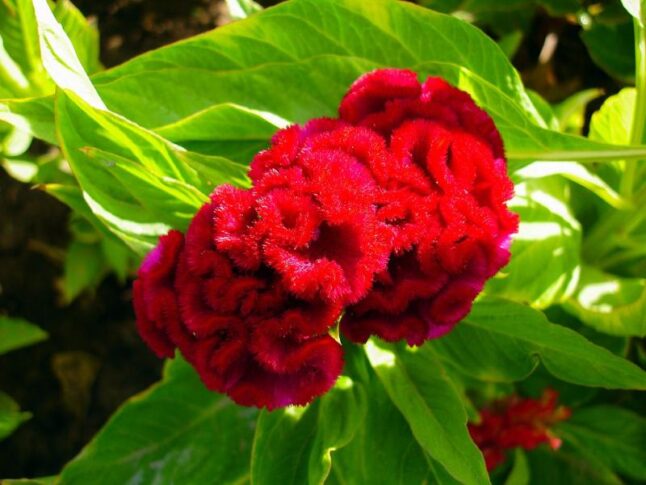
Native to Arizona’s low deserts, amaranth can also grow well at higher elevations, adding its shade and tall figure to cactus and rock gardens across the state. It’s a low-maintenance, low-water plant with unique red stems, dark green edible leaves, and bunches of pink and red flowers you can add to dried arrangements.
Type: Annual.
USDA hardiness zone: 2 to 11.
Sun exposure: Enjoys full sun but can also tolerate partial shade.
Drought tolerance: Very good.
Size: It grows 4 to 6 feet tall and wide.
Color: Blooms white, pink, or red from summer until the first frost.
Maintenance: Water once a week during summer.
Amaranth companions: marigold, sunflower.
Best Heat-Tolerant Shrubs for Arizona
Some perennial shrubs are incredibly resilient in Arizona’s low desert heat. They grow deep roots and dense foliage, shading the soil to keep it moist and cool. Shrubs add a green, lush look to your garden and dress up home walls, boulders, patio edges, and walkways. Here are some excellent options for Arizona’s climate:
Common Lantana (Lantana camara)
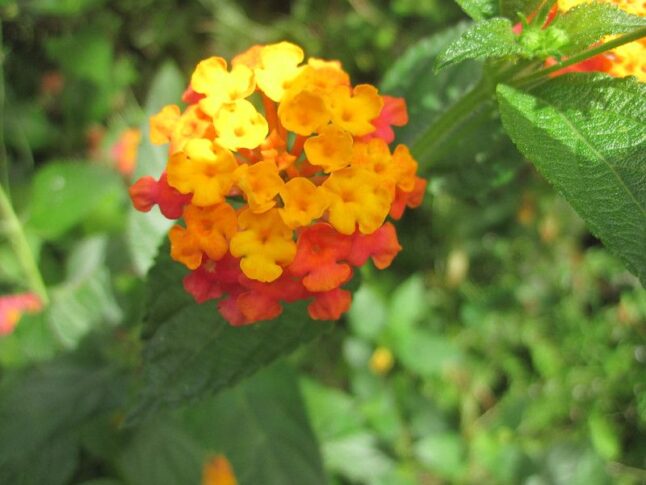
You’ll often see colorful clumps of lantana along the sidewalks and roadways of Tucson or Mesa. They’re easy to grow and bloom bunches of small, vibrant flowers from May to October, attracting butterflies and hummingbirds like a magnet.
Plant type: Perennial
USDA hardiness zone: 8 to 11.
Sun Exposure: Full sun. It flowers less in the shade.
Drought Tolerance: Good.
Size: 3 feet tall and 8 feet wide.
Color: Intense tones of pink, red, orange, yellow, purple, and white.
Maintenance:
- Water about 1 inch per week in the summer to promote flowering.
- Prune in the spring to about 6 to 12 inches from the soil.
- Lightly shear the tip growth during summer to promote reblooming.
Lantana companions: angelonia, salvia, boxwood, pentas, stonecrop.
Warning! Lantana is toxic for humans, pets, and livestock. If planted in a home yard, keep away from kids, dogs, and cats. It can cause rashes.
Red Bird of Paradise (Caesalpinia pulcherrima)
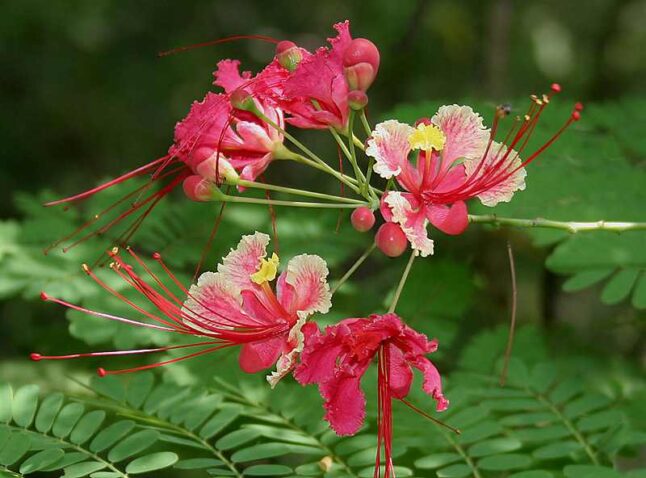
If you like large, colorful cones of flowers and delicate, feathery leaves, you’ll love the red bird of paradise. Grown as a shrub or small tree, this elegant plant welcomes metro Phoenix’s hot summers with gorgeous, bright blooms. It starts flowering in May and keeps at it until mid-fall.
Plant type: Perennial.
USDA hardiness zone: 9 to 11
Sun exposure: Full sun to grow dense and rich in flowers.
Drought tolerance: Very good.
Size: 6 to 10 feet tall and up to 8 feet across.
Color: Yellow, orange, and bright red shades.
Maintenance:
- Add them to your summer lawn care schedule and water deeply once every two weeks during the blooming season.
- Watch for iron chlorosis in heavy, alkaline soils and treat with iron chelate.
Red Bird of Paradise companions: aloe, yucca, ocotillo.
Baja Fairy Duster (Calliandra californica)
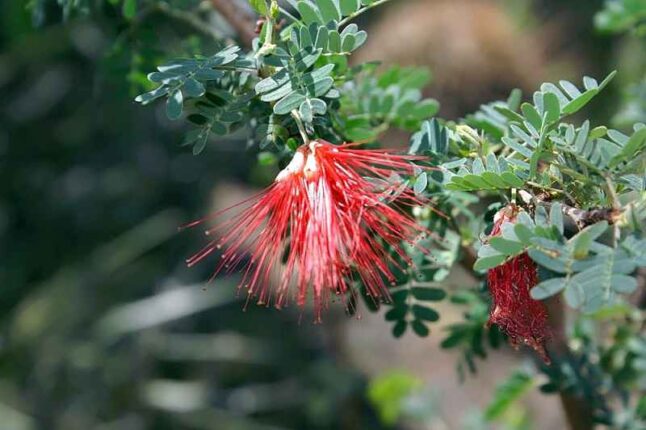
Native to the Sonoran Desert, this plant is as hardy as it gets, thriving in the hot summer days with little to no water. Baja fairy duster shrubs have delicate, feathery leaves and almost surreal blooms like powder puff balls. They flower from fall to spring, complementing Arizona’s winter lawns.
Type: Perennial.
USDA hardiness zone: 9 to 12.
Sun exposure: Full sun. It handles partial shade and reflected light.
Drought tolerance: Excellent.
Size: 5 to 6 feet tall and wide.
Color: Red, rose, or plum flowers.
Maintenance: Water once every two weeks during summer for more flowers.
Baja fairy duster companions: lantana, desert marigold, penstemon, blackfoot daisy.
Valentine Bush (Eremophila maculata ‘Valentine’)
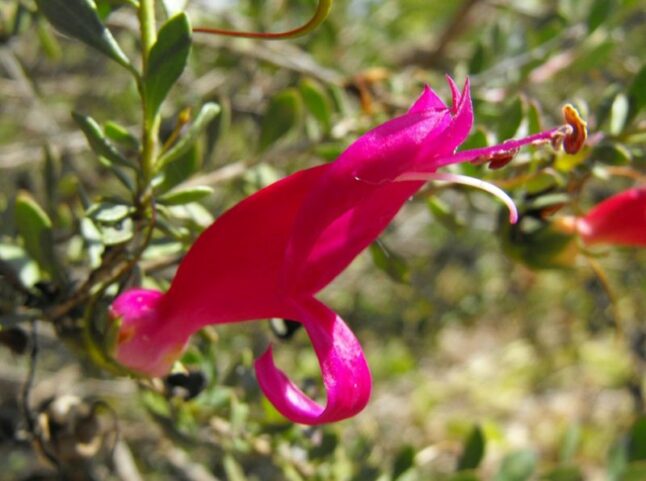
Also called emu bushes, Eremophila plants are native to Australia’s arid and semi-arid zones and are extremely drought-tolerant.
Used more often as an accent plant, this evergreen has large buds that bloom in elegant lily-like flowers during winter and spring. Its elongated leaves range from deep green to silver-gray, contrasting beautifully with the green of a winter ryegrass or tall fescue lawn.
Type: Perennial.
USDA hardiness zone: 9 to 11.
Sun exposure: Full sun.
Drought tolerance: Excellent.
Size: 6 to 10 feet tall and wide.
Color: It blooms lovely pink, red, and fuchsia flowers from winter to spring.
Maintenance: Water once a month to keep the flowers blooming.
Valentine bush companions: muhly grass, desert willow, salvia, palo verde, mesquite, yucca.
Sages (Salvia spp.)
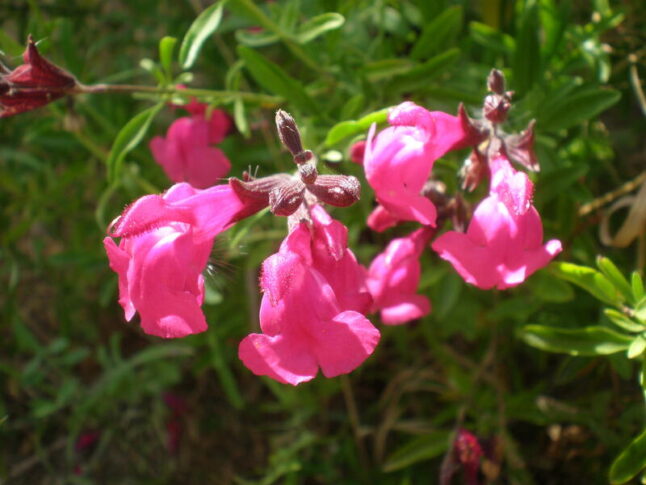
Salvia varieties have fragrant blooms in a variety of colors that seem to float above the rounded shrubs. They are an excellent addition to your wildlife garden corner. A tasty herb to cook with, salvia also looks amazing under your kitchen window and as a summertime drop of color in a rock garden.
Type: Perennial.
USDA hardiness zone: 4 to 10.
Sun exposure: Full sun. If you live in the Phoenix area or the southern deserts, ensure some shade in the afternoon.
Drought tolerance: Very good.
Size: 1 to 4 feet high.
Color: The most common varieties make red, pink, fuchsia, blue, and purple flowers. Some types bloom in white, yellow, orange, scarlet, and even red shades.
Maintenance:
- Cut back salvia in the spring.
- Trim the shrub to remove spent blooms and encourage continuous flowering.
Salvia companions: evening primrose, verbena, zinnia, black-eyed Susan, coneflower.
Desert Honeysuckle (Anisacanthus thurberi)
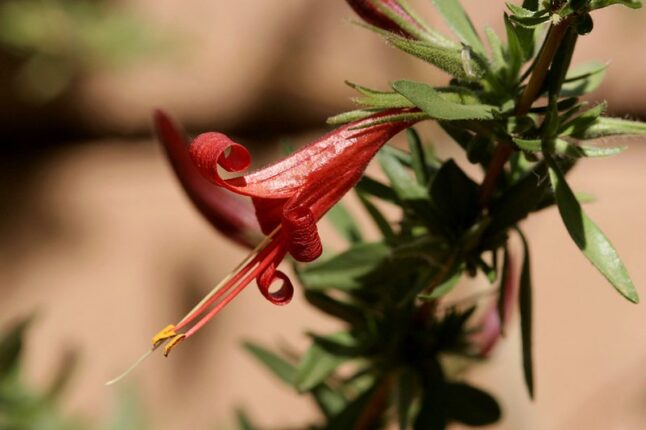
Honeysuckles grow in dense, upright shrubs with dozens of trumpet-shaped flowers and are a colorful backdrop for yucca, agave, and aloe.
This tropical beauty blooms heavily from March to November in bright red-orange shades loved by hummingbirds and butterflies. It can grow 5-6 feet tall, making an excellent hedge around leisure areas.
Type: Perennial.
USDA hardiness zone: 7 to 10.
Sun exposure: Tolerates full sun but thrives with morning sun exposure or under the canopy of desert shade trees like mesquite or palo verdes.
Drought tolerance: Very good.
Size: 3 to 6 feet tall and wide.
Color: Leaves stay dark green even in the heat, and flowers bloom yellow-orange, reddish-orange, or deep red.
Maintenance:
- It survives in the desert only with rainfall.
- Water twice a month during summer to promote generous blooming.
Desert honeysuckle companions: palo verdes, mesquites, clematis, muhly grass.
Texas Sage (Leucophyllum frutescens)
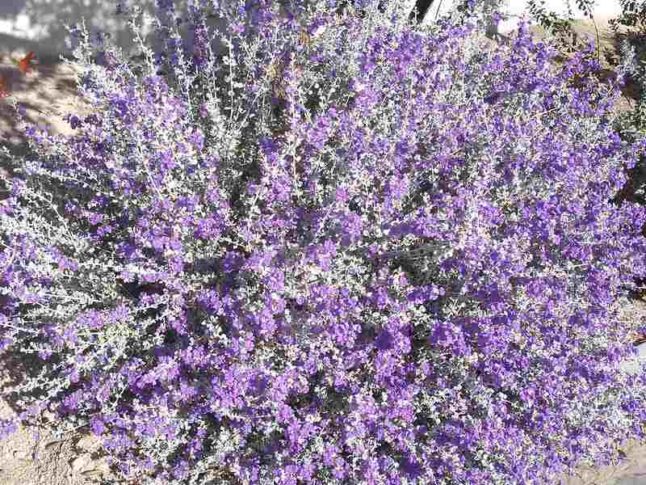
Native to the Chihuahuan Desert, Texas sage is the most fool-proof low-water perennial you can add to your landscaping. You’ll often see it around Tucson’s old houses, as it’s a versatile shrub with plenty of uses:
- Accent plant
- Focal point
- Windscreen
- Informal hedge
You can also trim it to grow as a small tree. Texas sage blooms heavily once the monsoons come, and some varieties fill the evening air with a charming fragrance.
Type: Perennial.
Sun exposure: Full sun and reflected light.
Drought tolerance: Good.
Size: 3 to 4 feet tall and 4 to 5 feet wide.
Color: Green, grey-green, silver-grey to silver-white foliage, and blue to deep purple flowers.
Maintenance:
- Doesn’t require pruning if you choose the right variety.
- Water deeply every two or three weeks during summer.
- Watch for iron chlorosis in heavy soils.
Texas Sage companions: ice plant, muhly grass, carissa.
Warning! If heavily pruned, Texas sage becomes woody and less attractive.
Yellow Bells (Tecoma stans)
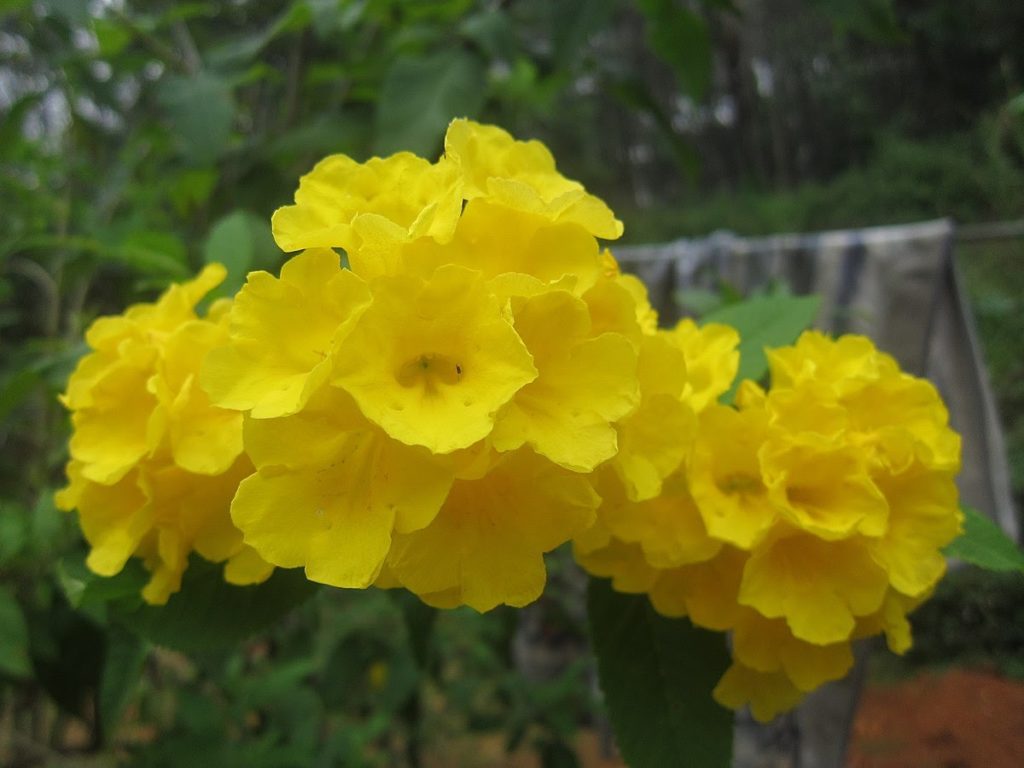
Yellow bells can be trimmed as large shrubs or small trees with bright bell-shaped flowers and are excellent for:
- Creating natural screens and barriers in your garden
- Growing against a wall to show off its beautiful flowers
- As a backdrop for some accent plants
It’s perfect for a pop of green in xeriscape gardens and fits like a glove around patios and ramadas.
Type: Perennial.
USDA hardiness zones: 9 to 11
Sun exposure: Full sun is required for good growth.
Drought tolerance: Moderate.
Size: 10 to 25 feet tall and 6 to 8 feet wide.
Color: Clusters of yellow, orange, apricot, or red bell-shaped flowers.
Maintenance:
- Cut back frost-damaged plants in late winter or early spring.
- Water periodically from spring to fall.
Yellow Bells companions: Arizona rosewood, Baja red fairy duster, desert marigold, agave.
Best Succulents for Your Desert Garden
Succulents and cacti are adapted to store water in their stems and leaves. They are among the most heat-resistant plants to grow in Arizona and have stunning shapes and colors. Here are the top options to consider for your yard.
Agave (Agave spp.)
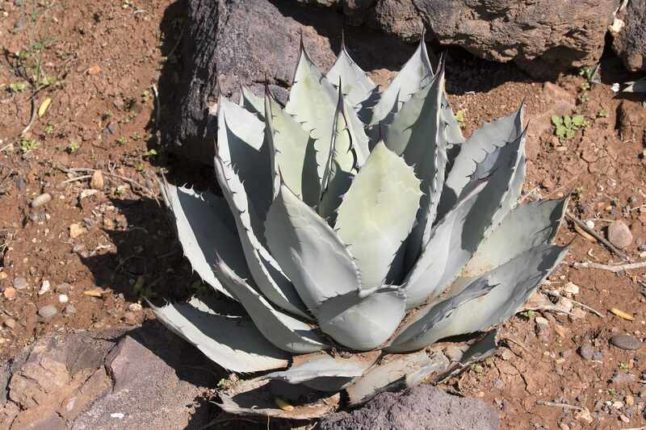
Agaves grow in large rosettes of fleshy leaves and are attractive desert succulents related to desert spoon, yucca, and beargrass. They form dense rosettes of leaves at the base and grow large enough to be a visual magnet in any succulent garden. Arizona’s most popular local species are:
- Agave parryi
- Agave chrysantha (century plant)
- Agave palmeri
- Agave utahensis
Remember that agaves are protected in the wild. You need a collecting permit from the Department of Agriculture and proper plant tagging to take some and plant in your backyard.
Type: Perennial.
USDA hardiness zones: 8 to 10.
Sun exposure: Full sun for at least 6 to 8 hours.
Drought tolerance: Excellent.
Size: 3 feet tall and 3 feet wide (smooth agave) to 7 feet tall and 12 feet wide (century plant).
Color: Leaves range from green to silver-gray and creamy yellow. Agave flowers are mostly yellow.
Maintenance:
- Irrigate every 4 to 5 days the first month after planting.
- Water two or three times a month after agaves are established.
Agave companions: bougainvillea, muhly grass, aloe, yucca.
Warning! Avoid placing agave near walkways or patios. Some have sharp leaves and grow quite large.
Yucca (Yucca spp.)
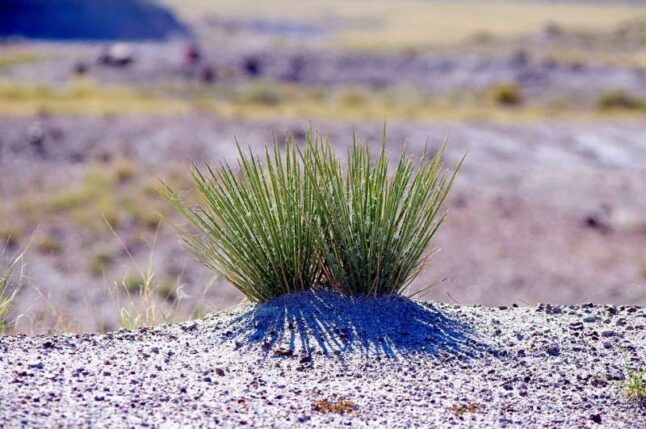
Spheric clumps of fleshy, sharp, sword-like leaves give yuccas a stunning look. Unusual foliage and tall, elegant, white flowers make them excellent accent plants for rock and cactus gardens.
Narrowleaf yucca, banana yucca, soaptree yucca, and Joshua tree are the most common varieties thriving in Arizona and available in local nurseries.
Type: Perennial.
USDA hardiness zone: 5 to 11.
Sun exposure: Full sun.
Drought tolerance: Very good.
Size: 3 to 30 feet high and 1.5 to 20 feet wide.
Color: It blooms creamy white flower spikes from March through May. The leaves are light green to gray-green with cream or white stripes in some varieties.
Maintenance:
- Yucca benefits from monthly soaking during the summer.
- Remove brown leaves.
- If it grows too tall, cut the main stem at the height you want to regrow from.
Yucca companions: aloe vera, boxwood, Texas sage.
Warning! Don’t place yucca near walkways or driveways. Their leaves cut and scratch the skin.
Aloe (Aloe spp.)
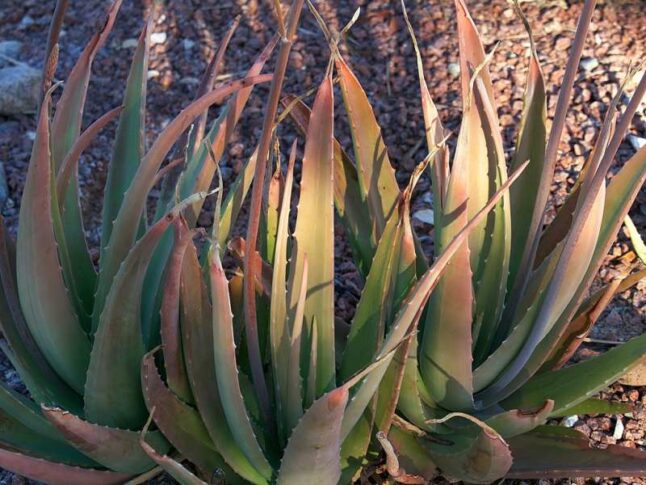
From low-growing ground covers to tree-like varieties, aloes are an excellent, drought-tolerant choice to make outdoor landscaping more interesting.
Aloes have fleshy, sharp-tipped leaves that range from deep green to silver-gray and majestic tubular flowers irresistible for beneficial insects and birds. Aloe vera also has healing properties, and you can use its gel to treat cuts and bruises.
Type: Perennial.
USDA hardiness zone: 8 to 11
Sun exposure: Grow aloe in partial or filtered shade to protect plants from sunburn.
Drought tolerance: Very good.
Size: Up to 2 feet tall and 6 feet wide.
Color: Aloes bloom in Arizona in winter and early spring in colors ranging from yellow and orange to coral red.
Maintenance:
- Water once a month.
- Remove dead flower stalks.
- Divide crowded clusters.
Aloe companions: catnip, marigold, weld morning glory, oregano, and nasturtiums.
Saguaro Cactus (Carnegiea gigantea)
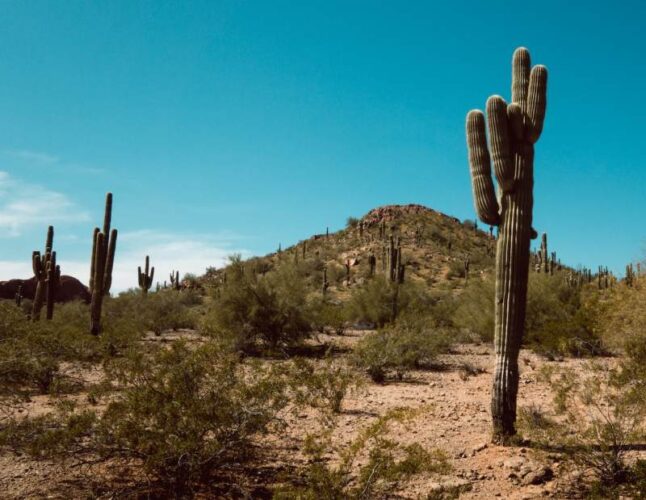
The Saguaro cactus is an impressive architectural plant, an iconic symbol of America’s southwest, and bearer of Arizona’s state flower. You’ll often see it in the urban landscapes of Tucson and Phoenix.
It’s very low-maintenance and highly resilient to heat and drought. While tall, the Saguaro has a low footprint, and you can grow a few in a medium-sized garden. It fits perfectly in a cactus or rain garden, watered only by rainfall.
Type: Perennial.
USDA hardiness zones: 8a to 10a. Not suitable for northern and far eastern parts of Arizona and elevations above 5000 feet.
Sun exposure: Full sun.
Drought tolerance: Very good.
Size: up to 60 feet tall.
Colors: Bright white flowers that bloom during springtime, at night.
Maintenance:
- The cleanest tree for your garden with just a few fallen flowers and fruits to collect in the spring.
- Fertilize with cactus food in the spring.
Saguaro cactus companions: yucca, aloe, agave, palo verde.
Barrel Cactus (Echinocactus spp.)
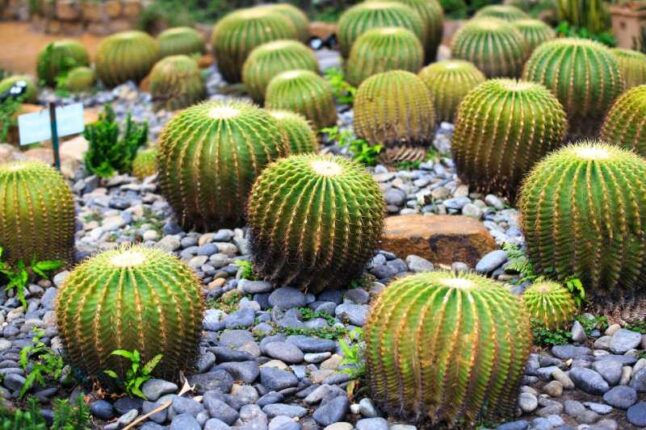
From a distance, mature barrel cacti look like soft, comfortable ottomans you could add to your living room. Please don’t sit on them, though. That smooth, airy, colorful halo is made of sharp spikes neatly arranged on the plant’s ribbed structure.
Their body is gray, light gray, or the deepest forest green you can imagine, and the spines contrast beautifully in shades of white, cream, yellow, or pink-red. Barrel cacti grow slowly, so you can enjoy them indoors in small pots for a while before adding them to your garden.
Type: Perennial.
USDA hardiness zones: 10 to 11.
Sun exposure: Full sun.
Drought tolerance: Very good.
Size: Up to 6 feet tall.
Colors: Flowers are yellow, orange, red, or pink. They bloom in April and change hue in May when starting to wilt.
Maintenance:
- Apply a fertilizer rich in phosphorus once a month from April to September to promote blooming.
- Remove dead branches and wilted flowers. No other pruning is necessary.
Barrel cactus companions: Saguaro cactus, lantana, aloe, agave.
Best Heat-Tolerant Trees to Grow in Arizona
Heat-tolerant trees are a good source of shade in the Arizona climate. They can shelter desert plants that can handle high heat but are sensitive to sunburns and create cool, pleasant leisure areas. Here are three drought-resistant, heat-tolerant trees to consider for your garden.
Mesquite (Prosopis spp.)
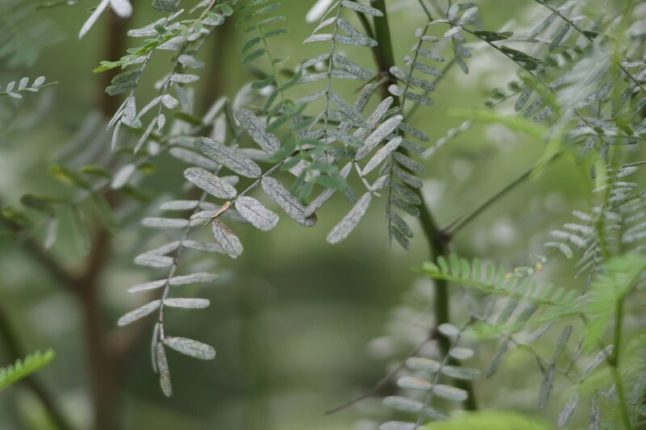
Casting light, filtered shade, mesquite trees are a good addition to areas where you grow shade-loving plants. They flower in late spring, signaling it’s time to seed or plant warm-season vegetables and collect nitrogen from the air, enriching the soil.
Mesquite trees have an extensive root system, giving them extraordinary drought resilience. The best varieties to consider are native ones, popular in the Phoenix and Anthem area, such as:
- Velvet mesquite
- Honey mesquite
- Screwbean mesquite (tornillo mesquite)
Type: Perennial.
USDA hardiness zone: 6 to 11.
Sun exposure: Full sun.
Drought tolerance: Excellent.
Size: 30 to 50 feet tall and across.
Color: Dark green leaves with white, cream, and pale yellow flowers.
Maintenance:
- Trim periodically to keep mesquite as a shrub or a small tree.
- Water deeply and occasionally during the summer.
Mesquite companions: agave, brittlebush, barrel cactus, ocotillo, desert lavender.
Warning! Their 3-inch long thorns make mesquite trees excellent natural fences but also not a good choice near walkways, driveways, and areas with a lot of foot traffic.
Palo Verde (Parkinsonia aculeata)
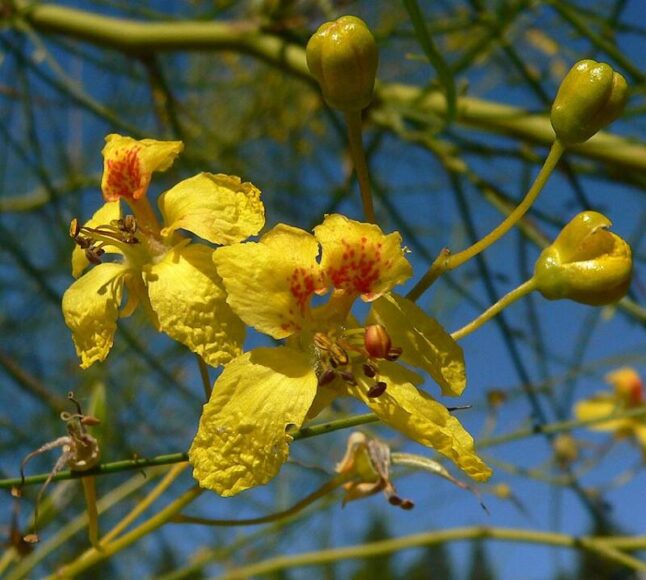
Palo verde trees have a unique green-to-blue-green bark that colors the landscape even during winter. They dress in a mass of bright yellow flowers in early spring, adding a warm light to your growing garden. Arizona’s most hardy and popular varieties are:
- Blue Palo Verde
- Littleleaf Palo Verde
- Sonoran Palo Verde
- Thornless Palo Verde
Type: Perennial.
USDA hardiness zones: 8 to 11.
Sun exposure: Full sun.
Drought tolerance: Very good.
Size: 15 to 30 feet tall and wide.
Color: Bark ranges from yellow-green to blue-green and gray. The flowers are mostly yellow.
Maintenance:
- Palo Verdes enjoy the occasional soaking during the summer.
- Don’t prune during the warm season. You’ll expose the tree to sunburn.
Palo verde companions: agave, desert willow, Texas sage, and Saguaro cacti.
Desert Willow (Chilopsis linearis)
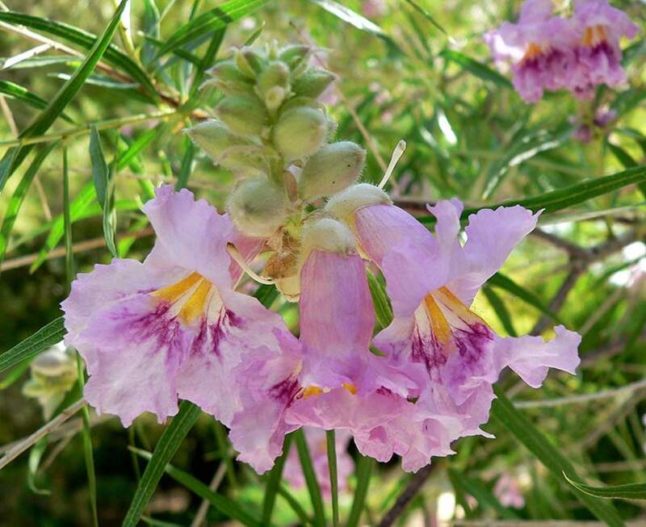
Native to the southwestern United States, the desert willow is a spectacular fast-growing tree to plant in your garden for shade and fragrance. It has glossy-green weeping leaves and orchid-shaped flowers, blooming in colorful clusters from April to October.
The lack of thorns or aggressive roots makes desert willow one of the best heat-tolerant trees to plant near walls or paving.
Type: Perennial.
USDA hardiness zone: 7b to 11.
Sun exposure: Prefers full sun but can tolerate partial shade.
Drought tolerance: Very good. It’s an excellent choice for xeriscape gardens.
Size: Up to 25 feet tall in 10 to 15 years.
Color: White, pink, to purple flowers.
Maintenance:
- Water once every two weeks in the summer to keep the tree lush and promote blooming.
- Reduce to once a month during winter.
- Prune in early summer.
Desert willow companions: yellow bird of paradise, red yucca, blackfoot daisy, aloe, agave.
Best Heat-Tolerant Ground Covers and Grasses for Arizona
Covering the ground with gravel or mulch is a great solution for a low-maintenance arid garden. But you can also use native heat-tolerant ground covers and grasses. Here are a few good-looking options to choose from.
Trailing Dalea (Dalea greggii)
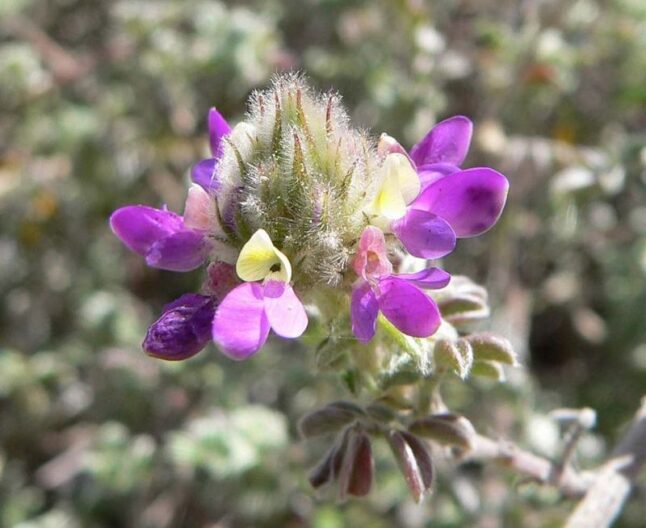
Native to the Chihuahuan Desert, trailing dalea is an excellent heat-tolerant ground cover for controlling erosion on sloped yards. Its tiny leaves form a soft silver-gray carpet that blooms lavender in the spring, creating a beautiful background for cacti, succulents, and flowering plants.
Type: Perennial.
USDA hardiness zones: 8 to 11.
Sun exposure: Full sun. It turns leggy in the shade.
Drought tolerance: Good.
Size: 5 to 6 inches in height and 6 to 10 feet wide.
Color: It has pea-like flowers in beautiful lavender shades.
Maintenance:
- Cut back every two to three years to promote blooming and new growth.
- Water occasionally during spring and summer to get a denser cover.
Trailing Dalea companions: agave, fairy duster, palo verde, brittlebush, sweet acacia, autumn sage, blue palo verde, and agave.
Muhly Grass (Muhlenbergia capillaris)
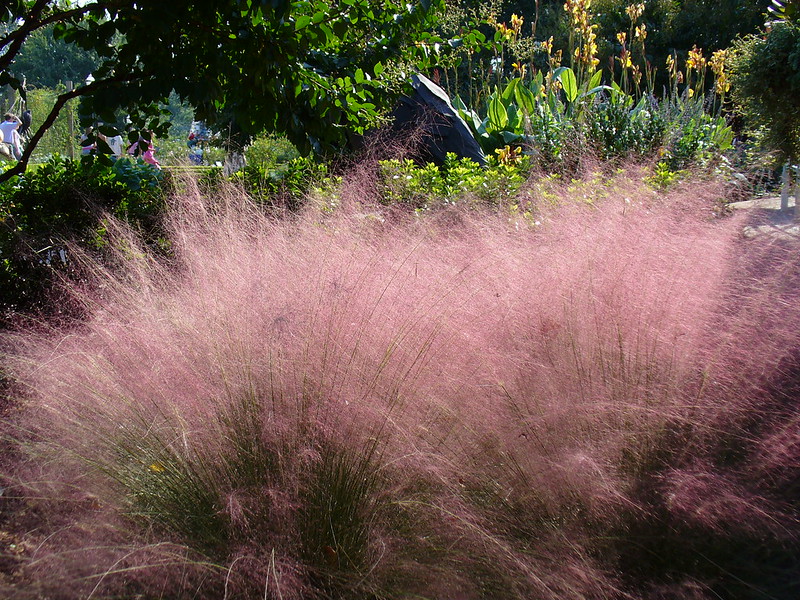
Another good fit for slopes, muhly grass is native to the elevations of the southwestern U. S. It looks incredibly soft and airy and gives a pro touch to desert landscapes when added around tree trunks, boulders, or rocks to smooth their looks. You’ll also love its whispering sound in the evening breeze.
It’s worth mentioning that it’s an ornamental grass, not a true grass. To find heat-tolerant turfgrasses, check our article on the best grass for Arizona.
Type: Perennial.
USDA hardiness zones: 5 to 11.
Sun exposure: Full sun but tolerates partial shade.
Drought tolerance: Very good.
Size: 1.5 to 5 feet tall.
Color: It blooms from April to November with tan, amber, pink, and rust-colored flowers.
Maintenance:
- Trim to the ground every two to three years.
- Muhly grass needs little water and survives on rainfall alone but looks better with some summer watering.
Muhly grass companions: black-eyed Susan, spotted bee balm, aster.
Mexican Evening Primrose (Oenothera berlandieri)
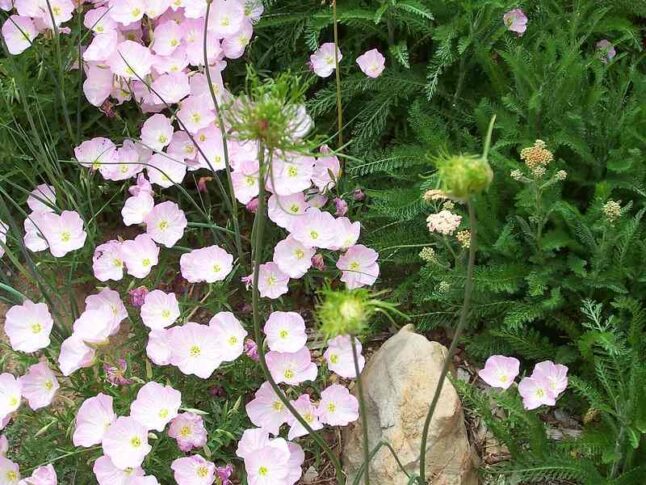
Imagine a carpet of delicate, broad pink flowers blooming bright in the late afternoon under your shade trees. That’s the Mexican evening primrose, a stunning low-maintenance ground cover you can add to any dry, open, informal garden. It flowers in early spring and can bloom all summer with added water.
Type: Perennial.
USDA hardiness zones: 4 to 9
Sun exposure: Full sun to light shade.
Drought tolerance: Good.
Size: 6 inches to 1 foot tall and 8 inches to 2 feet wide.
Color: Flowers have beautiful shades of pink. Leaves take reddish hues in drought and cold weather.
Maintenance:
- Clear the ground of old dead growth in late winter or early spring.
- Water infrequently during summer to prevent the plants from going dormant and promote blooming.
Mexican evening primrose companions: helenium, daylily, or salvia.
Verbena (Verbenaceae spp.)
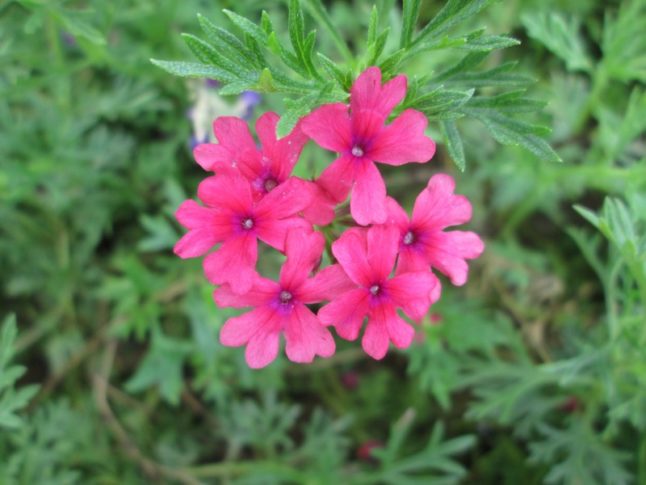
With clusters of tiny star-shaped flowers, verbena is a wonderful way to cover old edging and margins of raised flower beds in a carpet of bright colors.
Plant it in mass for visual impact, near patios, walkways, or boulders. You can cut some for your indoor space when half the flowers have opened. It’s an excellent filler flower for homemade bouquets.
Type: Annual, perennial.
USDA hardiness zones: 5 to 11
Sun exposure: Full sun.
Drought tolerance: Very good.
Size: 9 to 12 inches tall and 12 to 18 inches wide.
Color: White, red, purple, pink, lavender, bi-colored
Maintenance:
- Water weekly during the blooming season to promote flowers.
- Prune dried flowers and foliage for a beautiful, clean appearance.
Verbena companions: million bells, pentas, and marigolds.
Warning! The lemon verbena variety is toxic for dogs, cats, and horses.
Common Purslane (Portulaca oleracea)
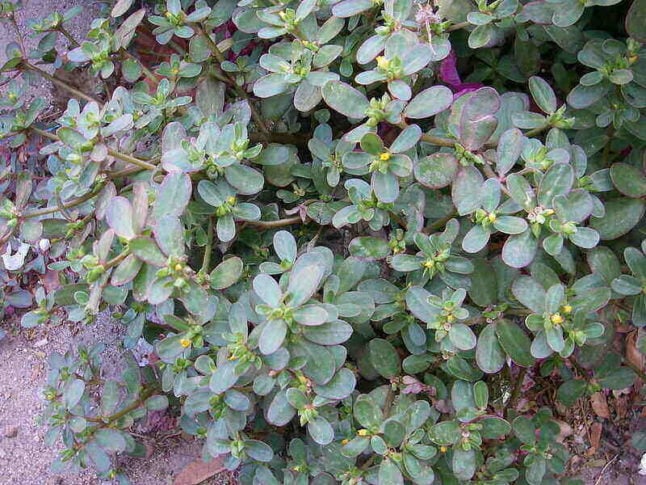
A low-growing succulent, purslane is one of the best ground covers you can pick for your rock or cactus garden. It is drought-tolerant and highly productive, coating the land in rounded, rubbery leaves and stems that handle summer heat very well.
Purslane creeps along the bare ground and digs in with deep roots, aerating the soil and effectively reducing excess salt.
Type: Annual.
USDA hardiness zones: 5 to 10
Sun exposure: Full sun.
Drought tolerance: Excellent.
Size: 16 inches long and 4 to 8 inches tall.
Color: Foliage ranges from green to brown and red. In good condition, sprinkled with small yellow, orange, white, or rose flowers.
Maintenance: Water once or twice a month during the summer.
Purslane companions: angelonia, calibrachoa, zinnias.
FAQ About Plants for Arizona Heat
Among the drought-tolerant plants that do well in Arizona’s high heat are cacti, agaves, aloes, yuccas, trees (mesquites, palo verdes), some shrubs (red fairy duster, Texas sage, cassia), and flowering plants (zinnia, amaranth, penstemon, marigolds, verbena).
Salvia, boxwood, lantana, marigold, bougainvillea, barrel cactus, aloe vera, and the prickly pear cactus are some of the heat-tolerant plants you can also grow in pots in Arizona. Placed outside in pots, they will require watering more frequently than the plants you have installed directly into the garden soil.
Some of the most popular heat-tolerant plants that can handle direct sunlight in Arizona summers are mesquite, palo verde, yucca varieties, agaves, cacti (barrel cactus, prickly pear cactus), Arizona yellow bells, Dalea, penstemon, verbena, and yucca.
If you want a green, lush lawn to complement your plant-filled landscape, check out our guide on how to grow grass in Arizona. It includes advice on how and when to plant summer and winter grass in Arizona to keep your lawn green all year.
Fill Your Arizona Yard with Amazing Plants!
Desert gardens are not as lush or green as Mediterranean or prairie ones but can look beautiful with native, heat-tolerant plants. From hardy cacti and agave to lean, tall shade trees, dense shrubs, and delicate flowering plants, you have incredible options to choose from.
Contact an Arizona landscaping company near you to get your heat-tolerant landscape project started! Whether you live in Phoenix, Mesa, Scottsdale, Glendale, or anywhere else in Arizona, LawnStarter has talented landscape designers to fill your desert garden with the most amazing plants.
Main Photo Credit: Ms. Phoenix / Flickr / CC BY 2.0





